Tuning a 12-string guitar can seem overwhelming at first. But with the information in this guide, you’ll be able to easily tune your 12-string guitar in a number of different tunings.
To tune a 12-string guitar in standard, remember that the strings come in pairs. Tune the first set of strings to normal 6-string tuning (E A D G B E). Then tune the lower four paired strings an octave higher (E A D G). Finally, tune the higher two paired strings the same as normal (B & E).
I’ll explain how to do this properly in this guide along with helpful diagrams.
In this guide, I’ll go through some common tunings for 12-string guitars, different types of tuners you can use, and other helpful tips.
When you’re ready to learn some songs, check out this list of the Top 12-String Guitar Songs. Guitar TAB is included for each song so you can learn the 12-string guitar parts straight away.
Difference Between 6 and 12 String Guitar Tuning
If you understand the difference between a 6 string and 12 string guitar, you will find it easy to tune your 12-string guitar in any tuning.
The main difference between a 6 and 12 string guitar is that a 12 string guitar has an extra set of strings paired together. There are 6 pairs of strings on a 12-string guitar.
If you think of a 12-string guitar as a guitar with six pairs of strings, it becomes much easier to understand.
Take a look at the photo below and you will see how there are six pairs of strings:
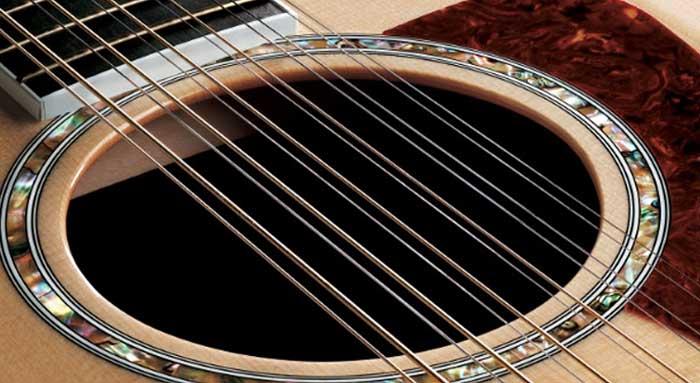
Notice that each pair of strings has a gap before the next pair of strings. You may also notice that the lower four pairs of strings are uneven in thickness. There is a thin string paired with a thick string. This is important to remember when tuning your guitar as the thinner strings are tuned to a higher note.
When you play a 12-string guitar, you don’t think about 12 individual strings. Instead, you think of 6 pairs of strings and you play each pair as if it were a single string on a normal guitar.
Keep this in mind when you tune your guitar up to any of the different tunings as covered below.
Once you learn how to tune a 12-string guitar, you can use any alternate tuning listed for 6-string guitars. Check out this Guide to Alternate Guitar Tunings for a list of open and other alternate tunings. Simply follow the advice in this guide and you can use any of those tunings on your 12-string guitar.
Tuning a 12-String Guitar to Standard (Step by Step)
The most common tuning for a 12-string guitar is Standard Tuning. This makes your 12-string guitar play the same as a normal guitar in Standard Tuning.
The key point to remember when tuning a 12-string guitar to standard is that each string is part of a pair. You don’t tune 12 individual strings, you tune 6 pairs of strings. Thinking about it this way makes it a lot easier.
Here’s a look at all of the strings on a 12-string guitar and what each string is tuned to:
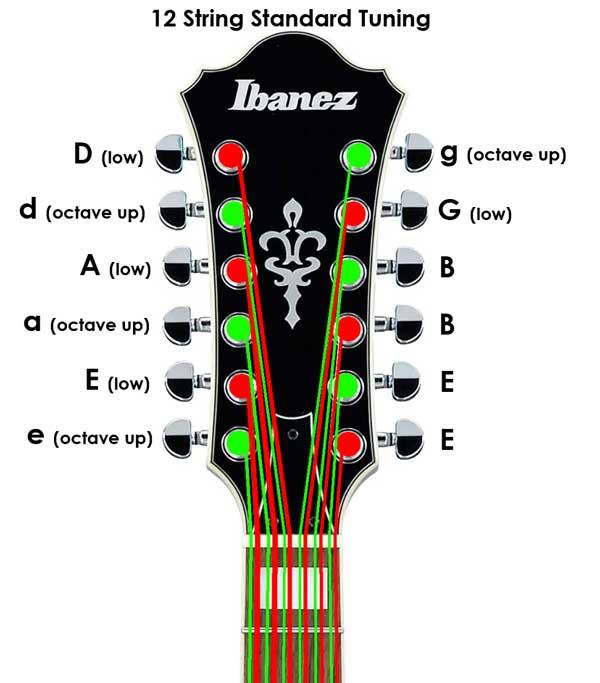
The strings highlighted in Red are tuned exactly the same as a normal 6-string guitar: E A D G B E.
When you look at the lower pairs of strings, it’s the thicker strings you tune like a normal 6 string guitar.
The strings highlighted in Green are the paired strings and we tune them differently.
The lower four pairs of strings (grouped with E A D G) are tuned an octave higher.
This means we tune the lowest string, E, an octave higher than the thicker E string. Then when you play those two strings together, you will hear that they both ring out in harmony. The sound you hear when both are in tune is an octave difference between the notes.
Tip: the thicker strings are always an octave lower than the thinner paired strings.
The higher two pairs of strings (B & E) are tuned exactly the same as the paired strings.
When you play the B pair of strings together, you will hear that they sound exactly the same.
When we write out the tuning for a 12-string guitar, we write it as:
eE aA dD gG BB EE
The uppercase letters are tuned to normal 6-string guitar tuning. The lowercase letters represent notes that are tuned an octave higher than normal.
From left-to-right in the earlier diagram, the strings are tuned:
- e: an octave higher than the thicker paired string
- E: normal 6-string guitar tuning
- a: an octave higher than the thicker paired string
- A: normal 6-string guitar tuning
- d: an octave higher than the thicker paired string
- D: normal 6-string guitar tuning
- g: an octave higher than the thicker paired string
- G: normal 6-string guitar tuning
- B: normal 6-string guitar tuning
- B: normal 6-string guitar tuning
- E: normal 6-string guitar tuning
- E: normal 6-string guitar tuning
After you try this once or twice, it will start to make sense and you’ll quickly feel comfortable with tuning your 12-string guitar.
If you’re ready to try to tune your guitar, skip ahead to the section on how to tune a 12-string guitar with a tuner.
Tuning a 12-String Guitar a Half-Step Down
If you look up songs for 12-string guitars, you may notice that a lot of them are tuned a half-step down.
The reason a lot of older 12-string guitar songs are tuned a half-step down is because of the tension standard tuning places on the guitar’s neck.
Having the tension of 12 strings pulling is a great strain on the guitar, so it used to be common to tune 12-string guitars down to take some tension off of the neck.
Tuning a 12-string guitar down a half-step is also a great way to get used to playing it. If you find your fingers hurt when playing a 12-string guitar, try tuning down to give your fingers some relief.
To tune a 12-string guitar a half-step down, tune your guitar as normal, then tune every string down a semitone (or half-step). This means E becomes E-flat (Eb), A becomes A-flat (Ab) and so on.
Learn more about Eb (E Flat) Tuning in this guide.
Here is a diagram of the strings on a 12-string guitar tuned a half-step down:
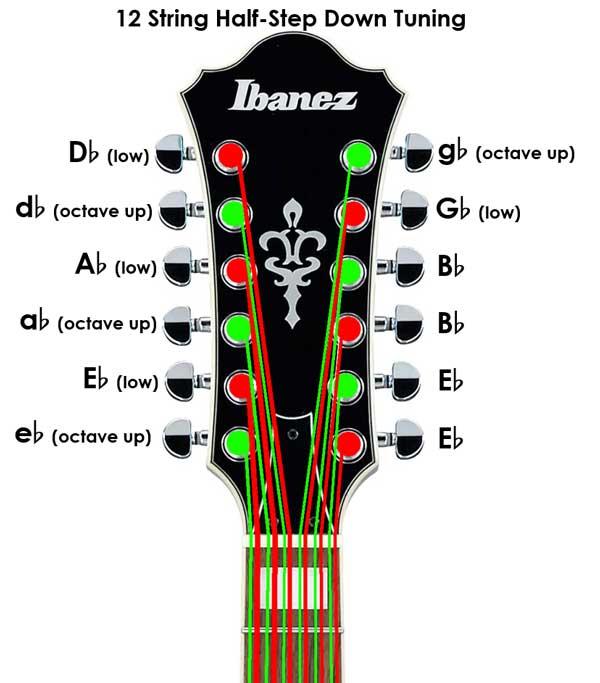
We still tune the strings as if there are six pairs and the lower four pairs are tuned an octave apart. The only difference between this tuning and standard tuning is each string is a half-step lower.
Tuning a 12-String Guitar to Drop-D
You can easily tune your 12-string guitar to Drop-D and play any song written for Drop-D guitars.
First, tune your 12-string guitar to standard, following the above steps. Then lower the low-E pair of strings down a whole-step to D. All other strings remain the same.
Learn more about Drop D Tuning in this guide for chords, songs, scales, and fretboard diagrams.
Here is a diagram of the strings on a 12-string guitar tuned to Drop-D:
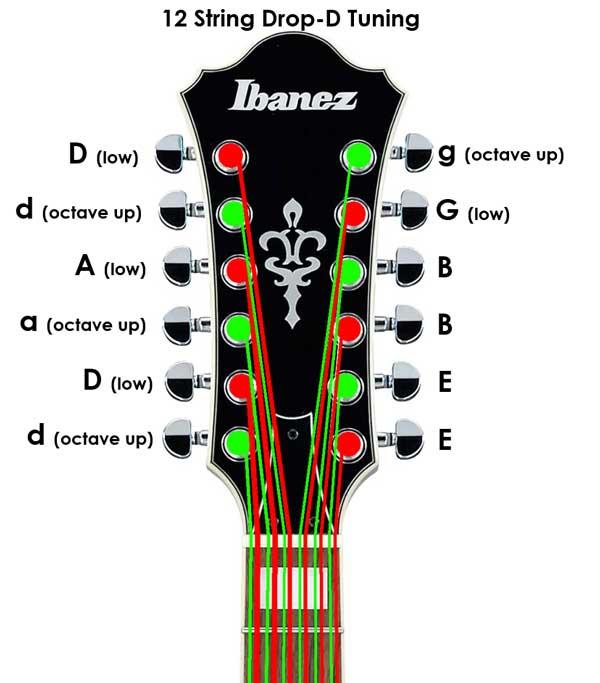
As you can see, only the lowest pair of strings change. The pair is still an octave apart, only this time they are tuned to D.
Tuning a 12-String Guitar to Open Tuning
You can tune a 12-string guitar to any open tuning you want. As long as you remember to tune the string in pairs and tune the lower four pairs an octave apart, you can use any open tuning.
Here are some common open tunings on 6-string guitars:
- Open E: E B E G# B E
- Open D: D A D F# A D
- Open C: E C G C G C
- Open G: D B G D G D
- DADGAD
Pick the above open tuning you want and tune the pair of strings as needed. Remember that the lower four pairs need to be an octave apart and the higher two pairs are tuned the same.
Check out this Ultimate Guide to Alternate Tunings to learn more about different tunings as well as songs to try out.
Here is an example of a 12-string guitar tuned to Open D:
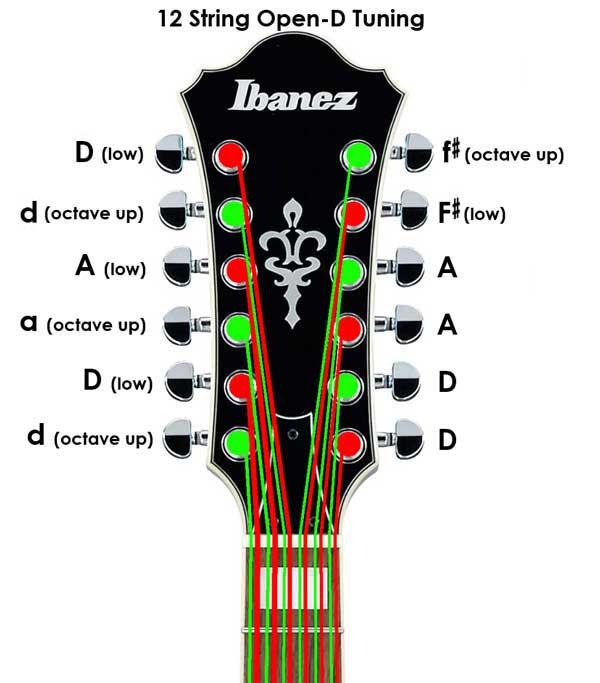
If you haven’t tried an open tuning on a 12-string guitar before, I highly recommend it (DADGAD is my favorite). They sound great on 12-strings.
How to Tune a 12-String Guitar With a Tuner
There are a few different ways you can tune a 12-string guitar depending on what type of tuner you have.
If you don’t have a guitar tuner, check out the Best Guitar Tuners in this guide.
Chromatic Tuner
The best way to tune a 12-string guitar is with a chromatic tuner. Most modern guitar tuners should have a chromatic mode.
A chromatic tuner is a guitar tuner that works for any note (Eg: C#, F, Bb, etc). This is great for tuning a 12-string guitar because four of the strings are tuned an octave higher than normal tuning.
To tune a 12-string guitar with a chromatic tuner, simply pick each string individually and the tuner will tell you what the current note is.
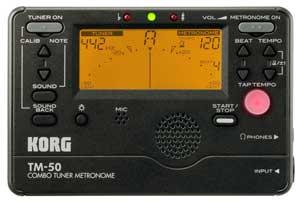
Then all you need to know is what to tune the string up or down to. I highly recommend starting with the strings tuned to normal 6-string tuning.
Once you have those strings tuned correctly, you can tune the paired strings. This will help you make sure you’re tuning the paired strings to the correct pitch.
Remember that the lower four paired strings need to be an octave higher. So first, tune them so they are the same as the paired strings, then continue to raise them until they are an octave higher.
Using this method will help you avoid breaking the paired strings.
Guitar Tuner Apps
There are some guitar tuner apps designed specifically for 12-string guitars. Searching for ‘guitar tuner 12 string’ in the app store will bring up a few different options.
Other apps such as the popular GuitarTuna app has 12-string guitar tunings available as a paid extra feature.
Even if the app you use doesn’t have a 12-string guitar feature, you can use any chromatic guitar tuner app. For example, the below screenshots of iStroboSoft’s tuner app is a chromatic tuner and works perfectly with a 12-string guitar.
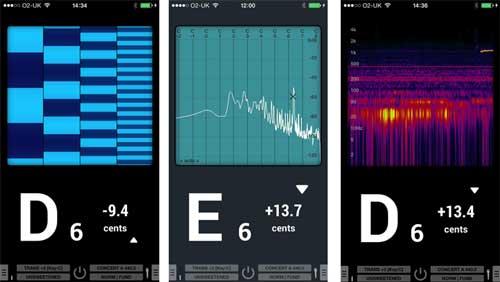
Check out the 12-string guitar tuning frequencies to know what note to tune each string to (eg: E3 or E2).
Roadie Automatic Tuner
I used to hate tuning my 12-string guitar. Having to go through so many strings would drive me nuts.
I now use an ‘automatic’ tuner by Roadie and don’t even need to think about what I’m doing.
You simply choose the tuning you want to set it to, then hold it over each string and it will automatically tune it to pitch as shown below:

In the above photo, I’m tuning my 12-string to Open G tuning.
Here’s how to tune your 12-string guitar using a Roadie 2 automatic tuner:
- Select ’12 String’
- Tap the button to bring up the menu
- Select ‘Change Tuning’
- Select the tuning you want. Here is the list of tunings that display:
- Standard
- Open G
- D Modal
- Drop D
- Open C
- Drop A (automatically created from a custom 7-string tuning I created)
- Hold the Roadie on the lowest string’s machine head and pick the string
- When the Roadie vibrates and lights up, move on to the next string
You can create custom tunings for 12-string or any other instruments, so if you want to add something like Open E or DADGAD, it’s pretty simple.
Read my full review of the Roadie 2 Automatic Tuner here to learn more.
12-String Guitar Tuning Frequencies
Here are the frequencies to tune a 12-string guitar from the lowest to highest strings:
- E3: 164.81 Hz
- E2: 82.41 Hz
- A3: 220.00 Hz
- A2: 110.00 Hz
- D4: 293.66 Hz
- D3: 146.83 Hz
- G4: 392.00 Hz
- G3: 196.00 Hz
- B3: 246.94 Hz
- B3: 246.94 Hz
- E4: 329.63 Hz
- E4: 329.63 Hz
I highlighted the thicker (normal) strings in bold to help you read the above.
Here are the frequencies on a diagram:
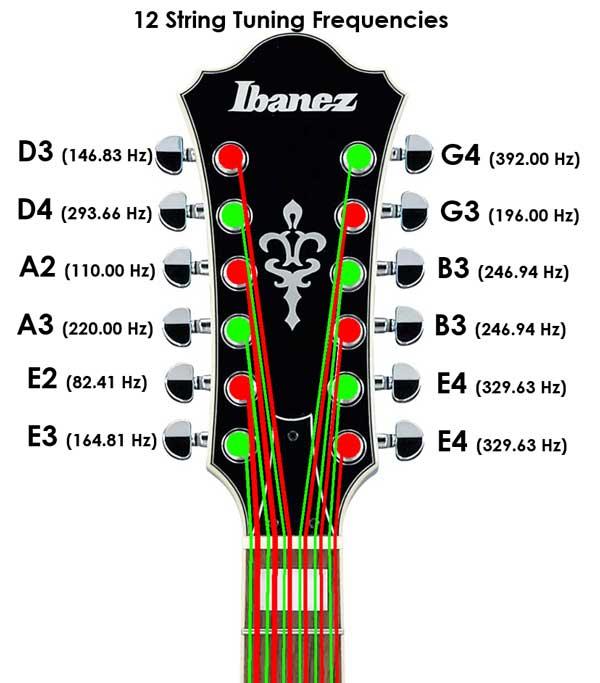
Remember that these frequencies are for 440Hz tuning.
12-String Guitar Tuning FAQs
Here are some common questions guitarists have about 12-string guitars and how to tune them.
Should a 12-String Guitar Be Tuned Down?
It used to be common to tune 12-string guitars down a half step or even a whole step. This was to reduce the tension the extra strings placed on the guitar’s neck.
You don’t need to tune a modern 12-string guitar down unless you want to. Modern 12-string guitars are designed to withstand the tension created from standard tuning.
While you don’t have to tune a 12-string guitar down, there are many 12 string songs that do use lower tunings. Tuning your guitar down will let you play those songs properly.
The good news about tuning a 12-string guitar down is that you can easily use a capo to continue to play your guitar in standard tuning.
I personally prefer to tune my 12-string guitar down a whole-step so I can play all songs written for lower tunings or standard tuning (with a capo).
Can You Put 6 Strings on a 12 String Guitar?
Yes, you can put 6 strings on a 12-string guitar and play it as a normal guitar. The guitar may feel strange to play due to the wider fretboard, but it will work.
I used to do this when the only acoustic guitar I had was a 12-string. I would remove the paired strings and keep the remaining strings in standard tuning.

As you can see in the above photo, I also shifted the strings over on the nut so the strings would feel more comfortable on the guitar. The strings feel incredibly awkward if left in their normal positions. Shifting the strings over isn’t recommended as it will damage the nut, but back then I didn’t have money for a 6-string acoustic, so it was my only option.
A nice benefit of playing a 12-string guitar with 6 strings is that you have plenty of room for your fingers between the strings. This makes playing chords more comfortable (for me, at least).
You may need to adjust the truss rod if you remove the extra strings as the reduction in tension will affect your guitar’s relief.
Find out how to properly adjust a truss rod and why it is important in this guide.
Can a Beginner Play a 12-String Guitar?
Beginners will find 12-string guitars harder to play than 6 string guitars. The extra strings require far more pressure from your fingers to ring out clearly.
If you find it hard to play chords on a 6-string guitar, a 12-string guitar will be painful.
You can make a 12-string guitar easier to play by tuning it down. By tuning down a half step or a whole step, you don’t need to press down on the strings as hard.
If you are a beginner, I highly recommend starting on a 6 string guitar and only start playing 12-string guitar when you have built up strength and control in your hand.
If you’re ready to try and play some 12-string guitar songs, this list of the Top 12-String Guitar Songs includes Guitar TAB for some great riffs and parts.
12-string guitars are only one of many different types of guitars. Check out this guide to learn about the different types of guitars you can buy. The guide explains the differences between different types of guitars, what styles of music you can play on each type, and whether they’re suitable for beginners.

